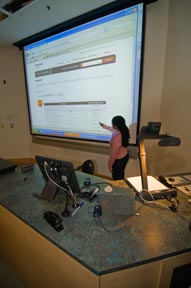



On April 28, 2010, OIT held an open house for the Stinson Collaborative Commons. The OIT Unity Laundry Lab was renovated and reimagined as a collaborative work space for students.
- INTRODUCTION
- PROGRAMS
- COMPACT PLAN
- DIVERSITY INITIATIVES
- STAFF
- RECOMMENDATIONS AND CONCERNS FOR THE FUTURE
A shorter version of the report is available as a .pdf file
INTRODUCTION
For NC State’s Office of Information Technology (OIT), 2009-10 was a year of new partnerships and new strategies for helping the university advance its strategic focus areas – while reducing costs, implementing new services, upgrading existing services, and meeting regulatory requirements.
OIT was formed in fall 2007 to consolidate the university’s central academic, research and administrative IT organizations and to improve the efficiency, effectiveness and coordination of information and communication technologies (ICT) at NC State. OIT is responsible for planning, providing and supporting the use of the university’s core ICT, ranging from its data networking and cyber-infrastructure to essential software and administrative information systems.
Led by Vice Chancellor and CIO, Dr. Marc Hoit, OIT is made up of eight units: Advanced Computing (AC), Eric Sills, director;Business Services (BusServ), Karen Horne, director; Communication Technologies (ComTech) Greg Sparks, director; Enterprise Application Services (EAS), Gwen Hazlehurst, director; Infrastructure Systems and Operations (ISO), John Black, director; Outreach, Communications and Consulting (OCC), Stan North Martin, director; Security and Compliance (S&C), Mardecia Bell, director; and Technology Support Services (TSS), Susan West Klein, director.
PROGRAMS
Scope of Services
During 2009-10, campus and statewide budget cuts strengthened OIT’s commitment to collaborative engagement, innovation, agility and alignment. While OIT provides NC State’s essential campus-wide ICT infrastructure and services, OIT is responsible for less than half the university’s ICT staff, desktop computers, servers, student computing labs and research computing. Everyone was hit hard by the 2009-10 fiscal year budget cuts. OIT’s budget reduction was $2,357,502 (10% of state appropriated funds), and the equivalent of 24 full-time positions were lost. Meanwhile campus needs and expectations for OIT’s help and services increased, along with security risks, and state and federal regulatory requirements. Rather than reduce the scope of OIT services and engagement, OIT has pursued new options for partnerships, strategic alliances, service delivery and decision making. Highlights include:
- Partnership with UNC-Chapel Hill – In fall 2009, NC State and UNC Chapel Hill agreed to jointly develop, implement, operate and upgrade their PeopleSoft Human Resources and Financials administrative software systems. The Joint Enterprise Services partnership is intended to leverage the strengths of both institutions to provide robust services for reduced costs.
- Outsourcing student e-mail services – In collaboration with colleges and student support units across campus, OIT announced in early 2010 the decision to outsource NC State’s official student e-mail services to Google’s free Google Apps Education Edition services. This was unquestionably one of the year’s most popular campus cost-cutting measures with students. The service, which offers students enhanced collaboration tools and 7 GB of storage, will be deployed to all students by the fall 2010 semester.

- Expanded regulatory requirements – Highlights include efforts to bring the university into compliance with new copyright provisions of the Higher Education Opportunities Act (HEOA); responding to increased Public Record, litigation hold and eDiscovery requests; and the decision to deploy Google’s Postini central e-mail archiving and antispam and antivirus services during 2010 to help NC State employees comply with Public Records law in relation to e-mail.
- Alliances to cut campus ICT costs – Vice Chancellor Hoit launched several task forces with college IT leaders in 2009 to work on cost-cutting strategies. The group working on consolidating campus IT purchasing collaborated with the UNC-General Administration, which this May announced the new system-wide Combined Pricing Initiative (CPI). The CPI will give all UNC institutions the benefits of combined purchasing for PCs and laptop computers.
- Alliances to enhance campus ICT – OIT staff are participating in a digital asset storage capacity of Triangle universities.
- Collaboration to enhance the well-being of North Carolinians and the nation develop systems to accurately detect and quickly analyze biological hazards to ensure public health and safety.
- Working together to improve IT Governance – Efforts to improve and coordinate ICT decision-making processes accelerated this year. In addition to numerous advisory teams created in connection with specific projects, highlights include the formation of a new Information Technology Student Advisory Group, Messaging (electronic) Steering and Technical Committees and the launch by Vice Chancellor Hoit of a process to develop a new inclusive IT Governance model for the university.
Special Program Reviews, Studies and Plans
- Assisted with creation of Federal Trade Commission Red Flag Rule credit card anti-identity-theft procedure.
- Investigated HEOA copyright file-sharing provisions and created plan for compliance.
- Developed framework of regulations and controls to protect sensitive data from breaches.
- Coordinated successful close-out of Office of State Auditors 2008 IS Audit as well as no findings in IS portion of their annual Financial Audit for 2009-10.
- Developed OIT Priority Road Map to help identify and prioritize the many projects that need to be completed.
- Produced 2009 OIT Risk Summary Report that identifies risks with associated mitigation strategies for a more secure, robust, efficient and effective central IT environment.
- Developed Core Services Resilience Plan that identifies recovery steps and associated time frames for the enterprise software environment in four scenarios.
- Completed “How Green is (O)IT” report, to assess opportunities for enhancing OIT participation in campus sustainability efforts and climate action planning.
Other major achievements and milestones
Helping NC State do business better- and more cost effectively:
- Campus IP telephony project – Transitioned 6,000 analog lines from AT&T service to the Cisco call-manage system, resulting in more than $300,000 annual savings.
- Outsourced student e-mail services – Will save an estimated $200,000 annually.
- Software licensing services – Coordinated termination of software licenses/maintenance and the new license model for Autodesk saved campus more than $370,000 this year.

- Student Information System (SIS) – New Student eBilling improves services and saves $50,000 previously paid annually to external vendor. Advising module implementation is set for summer 2010: no consultant fees were required. New Financial Aid module is on schedule for January 2011 implementation; estimated $30,000 annual savings.
- SAS Business Intelligence (BI) tools implementation – Saves an annual $60,000. OIT is partnering with University Planning and Analysis in developing an administrative data mart with SAS BI. Target release date, fall 2010.
- Parent Portal to provide easy access to parent services such as online bill payment.
- New Capital Improvements System (CAPS) in the Financials System – Will enhance business functioning.
- Online W-2s for employees – Saves printing and postage costs.
- New version of the MySoft Asset Management tool – Provides a self-service Web application to simplify requests for campus phone services.
- Classroom and conference room technology programming and integration services – Saves $2000/room for control system programming and $4000/room for integration.
- Decommissioning the campus mainframe set for Dec. 31, 2010 – efforts will result in an annual savings of $500,000.
- Reduced phone rates for 2009-10 – OIT reduced the telephone rate from $9 to $7 per line per month to help with tight budget year for departments.
Upgrading university’s ICT infrastructure:
- Overall network improvements – Removed outdated 10Mb/s switches from the network, upgraded both of our Internet (NCREN) links to 10Gb/s, and completed bandwidth upgrades on the core of our network to 4Gb/s as an intermediate step while awaiting Cisco’s newest equipment line in 2011.
- Network monitoring enhancement – Created network weather map of the core network to show bandwidth utilization. Also set thresholds on those links to pro-actively identify links that need to have bandwidth increased before they get over subscribed.
- Wired network ports – Grew from approximately 62,000 to over 63,000.
- Wireless network – Added wireless access points (APs) in 11 mini-zones and 13 residence halls with a total projected installation of nearly 1200 APs by the end of June 2010; from January to May 2010, an average 18,160 people used the campus wireless network daily; the network has the capacity to support more than 28,500 concurrent users. Developed and shared 802.11n road map outlining strategy for adopting the next generation of Wi-Fi technology.
- IPTV – Pilot project launched in June. Students subscribing to campus cable TV will have access to additional channels from their computers.
- Data centers – Facilities improvement programs have been initiated in both campus primary data centers to sustain service and attempt to accommodate growth.
- Server virtualization – Extended into additional platforms and leveraged to consolidate separate instances; will benefit operational flexibility, improve energy efficiency, and reduce costs.
- Data mart and document imaging systems – Developing infrastructure to support these new services.
- PeopleSoft infrastructure – Upgraded to support new partnership with UNC-Chapel Hill.
Responding to security risks and enhancing ICT access management:
- Security incident and computer misuse investigations – Averaged 51/month. The number of incidents varied from 35 per month to a peak of 71.
- Digital Millennium Copyright Act (DMCA) notifications – Copyright infringement notifications increased to an average of 148/month (from 80) with a peak month of 351 (up from 202, highest monthly volume in the last 3 years). Nomad wireless notifications more than tripled for last six months (avg. of 104/month). DMCA notification follow-up now handled by Student Conduct and Employee Relations.
- Public record, litigation hold and eDiscovery requests – Continued to increase.
- Identity and Access Management (IAM) Initiative – In collaboration with campus and national partners, coordinated creation of IAM Roadmap, created Oversight Subcommittees and expanded IAM working groups to enable secure and reliable access to campus ICT resources.
Advancing research:
- High Performance Computing (HPC) facilities use – Students and researchers from 27 departments in 6 colleges used HPC services. About 10 million processor-hours of HPC services were used by 96 projects and 290 users compared to about 7 million processor-hours used during 2008-2009.
- Grant-funded research using HPC – Researchers using HPC have more than 100 million dollars of currently active grants.
- HPC Partners program – Faculty partners have purchased most of the HPC hardware. These resources are available to other HPC users when not being used by the faculty partner.
- HPC cost savings – The 10 million hours of HPC cycles delivered by OIT’s HPC service would have cost $3.4 million if purchased from an external provider, compared to about $700,000 annual base funding for all OIT HPC services.
- Code donation to Apache Software Foundation – First Apache release of VCL completed this year; Apache VCL community activity increasing.
Improving technology support:
 Angel.com system – Rolled out for Help Desk and Cashiers Office; improves call handling, resiliency and customer service.
Angel.com system – Rolled out for Help Desk and Cashiers Office; improves call handling, resiliency and customer service.
- Classroom technologies and support – 26 additional classrooms, bringing the total number to 115.
- Standardization of classroom response systems (“clickers”) began in Fall 2009, along with ClassTech-provided support for these devices. OIT supports clicker use in 57 general use classrooms covering approximately 2,800 seats.
- RoomView Services – Allows the monitoring of devices in classrooms to enhance support and provide usage metrics. This service is also offered to other units for the oversight of rooms managed by colleges and departments.
- Administrative managed desktop service – OIT is developing a new business model and an updated managed desktop environment based on Microsoft Windows Active Directory.
- The OIT Walk-in-Center (WIC) – Expanded warranty repair services and certifications, gaining A+, Lenovo Administrator and Apple certification.
Fostering collaboration, community and learning with ICT:
- Computer Security Day 2009 – Collaborative day-long event in student center, with 2 keynote addresses and 12 sessions with 3 tracks of IT security topics.
- Stinson Collaborative Commons – The OIT Unity Laundry Lab was renovated and re-imagined as a collaborative work space for students.
- VCL use – Grew by almost 25% to 435,000 hours of use by 12,000 NC State users in the past year; use by other NC institutions grew to about 74,000 hours of use by about 4000 individuals.
- NC State’s Mobile Web and Twitter sites – In collaboration with NCSU Libraries and others on campus, createdm.ncsu.edu, a Web site that provides NC State content to mobile devices. Collaborated with University Communications and others to enable the new aggregation site, twitter.ncsu.edu, for NC State organizations using Twitter.
- ITunes U at NC State – Campus-created content grew dramatically; an average of 17,000 tracks downloaded monthly.
- WolfBytes Sports – Launched in 2009 in collaboration with NC State Athletics and Campus Recreation, now has a library of over 300 sporting events.
- Student and employee orientation – Conducted 37 presentations and 19 Info Fair sessions for students and their parents during 2009 New Student Orientation to educate students about ICT resources and acceptable use. Conducted 35 presentations for new employee orientation.
- Free training and workshops – Popular Lunch and Learn series offered 27 informal sessions to staff and faculty on various technology-related topics; free hands-on training offered on 34 software and technical topics throughout the year; conducted 24 custom workshops.
- Web design and content – Enriched OIT Web with new video tutorials and other informative content; Web redesign services provided for departments across campus.
- Publicity campaigns – For Google Apps Beta services, Green IT, security events and other new services and issues.
- OIT News – Posted regularly online and on Twitter; monthly e-newsletter for staff and faculty.
Improving work conditions of staff:
- Completed renovations of Avent Ferry enabled the return of Communication Technologies and Enterprise Application Services staff, the use of warehouse space, and improved staff training and meeting facilities.
COMPACT PLAN
Note: These projects predate OIT as an organization, since OIT was formed in late 2007 and did not participate in the most recent Compact Plan process.
- Surpassed baseline performance for data network backbone with 99.9999% availability.
- Completed IPT Phase I resulting in substantial cost savings (over $300,000 annually).
- Significant work has been completed to generate the University Directory from the HR and Student Information Systems. Target completion date is Fall 2010.
- Continued the Payment Card Industry Data Security Standard v1.2 compliance; generated new requirements and workload.
DIVERSITY INITIATIVES
OIT’s most visible Diversity Initiative continues to be its IT Accessibility Services, which support the university’s commitment to equitable access to opportunities for students and employees with disabilities. Working in partnership with accessibility experts and colleagues at NC State and other institutions, this service focuses on identifying, deploying and educating Web developers, content providers, faculty and others on best practices and proactive solutions to ensure the accessibility of the university’s IT resources. During 2009-10, OIT helped lead the formation of NC States’ new campus-wide IT Accessibility Advisory Working Group. The group will help redefine the job description and lead the search for a new University Coordinator of IT Accessibility.
OIT also supports the university’s commitment to create a diverse and inclusive campus community in terms of gender, disability, sexual orientation, race and ethnicity. Currently, of OIT’s 266 staff about 32% (86) are female and 68% (108) are male; 76% identify themselves as White, 12% (31) as African American, 7% (18) as Asian, 2% (6) as Hispanic, 1% (3) as American Indian, and 2% (4) as two or more races.
STAFF
Professional Activities
Gail Gregory graduated from the Equal Opportunity Institute program.
“Move That Bus,” by Jason Austin and Garrison Locke, published on Zend Developer Zone, August 9, 2009.
Rick Brown is serving on the Board of Directors for Association of Higher Education Cable Television Administrators (AHECTA) and is co-chairing the 2010 national conference.
Marc Cloutier is serving on the Building Industry Consulting Services, International (BICSI) NxtGEN Curriculum Process Development Subcommittee.
Yessy Mendoza-Tate continues to serve on the Oracle General Ledger Product Advisory Group.
Mark Scheible serves on the EDUCAUSE IAM Working Group and was appointed to InCommon/Internet2 CAMP Program Committee for its annual workshop. Mark will co-lead the Pre-Conference and moderate the Technical track.
Greg Sparks is completing the first year of a two-year appointment as Chair of the UNC NetStudy working group.
Susan Klein is chair of UNC-CAUSE. Sarah Noell is chair of the state-wide conference to be held November 8-10, 2010 in Wilmington; Jason Austin, Jen Riehle, Harry Nicholos, Eric Silberberg, David Ladrie, Kristina Kelly, Franklin Finch, Larry Robinson are among the OIT staff planning this event.
Pathways Leadership Development Program graduates included OIT’s Twanda Baker; Marilou Coggins; Thomas Farwig; Beth Jones and Patricia Palmer.
All OIT managers participated in monthly Power Hour management skills training led by Tina Bennefield of Human Resources.
Todd Gunderson and Mariela Montero presented “MySoft Asset Management Application” at the Compco Users Conference in June. Taylor Lundy presented on “MySoft Shopping Cart” at the conference also.
Cheryl Cleveland presented “The What, Where and Why of PeopleSoft Upgrades” at the Oracle Alliance 2010 Conference in March. Yessy Mendoza-Tate and Tom Reynolds also presented at the conference.
Mark Scheible was a guest speaker on the InCommon IAM Online series. He spoke on “Hot Topics and Current Issues in Identity and Access Management” on March 11.
“X as a Service, Cloud Computing, and the Need for Good Judgment,” by Dr. Henry Schaffer, published in the September/October 2009 issue of IT Professional, a publication of the Institute of Electrical and Electronics Engineers (IEEE) Computer Society.
“Cloud with a Long Tail: The VCL in Support of Pedagogy,” by Dr. Henry Schaffer and Dr. Sarah Stein, published in the May/June 2010 EDUCAUSE Review.
Recognition
Nicholas Young and John Martin received the 2010 Office of Information Technology/University Awards for Excellence. Also nominated were Brandon Barbour, Debbie Carraway, Jack Foster, Dean Irving, Ron O.N. Jailall, Stan North Martin, Ed Rogers, and Maria J. Strine.
Jason Valencia won a Provost’s Spotlight on Disability award for his work with the Disability Services Office.
Wenyi Li received a University Housing Service Award for “the outstanding contributions she made to the development of the Housing System.”
Jude Davis received the 2010 Earthwise Award for NC State staff.
OIT winners of University Pride of WolfPack program awards during 2009-10: Mildred Brown, Susie Rambeaut, Darren Fallis,, Tim Lowman, Nick Young, Ed Rogers, Kenneth McEntire, Marc Kuh, Rhonda Greene, Wade Cornett, Kevin McDonald and Bill Coker.
RECOMMENDATIONS AND CONCERNS FOR THE FUTURE
Staff: All OIT units have ongoing concerns about the budget and the availability of resources, including management resources to oversee and coordinate the large volume of planned technical activities and funding resources to provide competitive salaries to retain and recruit adequate staff to support complex services and increasing customer and compliance requirements. The wide dispersion of OIT staff across campus continues to significantly impede communication collaboration and cohesion.
Recommendations: Maintain senior management commitment for sufficient resources for priority projects; work to resurrect the “Triangle rate” for IT banding and find funds to reward top performers.
Security and regulatory impacts: Increasing security threats and new regulations threaten to create an overwhelming workload and number of unfunded mandates in terms of staff time as well as hardware and software. For example: potential changes to the Universal Service Fund; possible net neutrality legislation; new requirements of the Higher Education Opportunities Act (HEOA); very high volume of new security incidents; dramatic increases in Digital Millennium Copyright Act (DMCA) notifications for possible illegal file sharing on wireless network; and greater pressures in general for heavier regulation of network services.
Recommendations: Maintain engagement of university leadership in security and regulatory issues; provide adequate funding for new tools such as automated procedures for DMCA notifications and for priority projects such as approved Identity and Access Management; implement IT and data security awareness training for all university faculty and staff.
Technology: NC State’s need for a new data center became distressingly apparent this year, as several power and cooling incidents in the university’s primary data centers led to service outages and risks to critical university system and data. Both data centers are operating at capacity. This has led to the proliferation of server rooms across campus roughly equaling the amount of servers and equipment in the central data centers, but at much higher operational and energy costs. Campus-wide, ICT is responsible for more than 5% of campus electricity consumption, and the campus Climate Action Plan is calling for strategies to improve power management in data centers and for computers across campus. Other technology concerns include the content licensing implications of the new I-based cable TV service for students and the ability to respond to the rapid evolution of wireless and mobile technologies. For example, while OIT plans to deploy next-generation Wi-Fi technologies (802.11n), competing cellular technologies may require a separate infrastructure.
Recommendations: Maintain engagement of university leadership in ICT issues and raise awareness that investing in many high-priority ICT projects can serve the university’s goals while saving operational costs.

